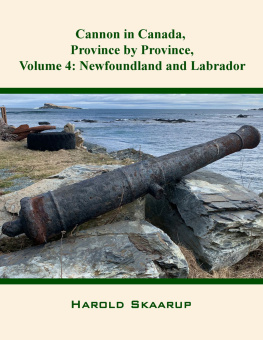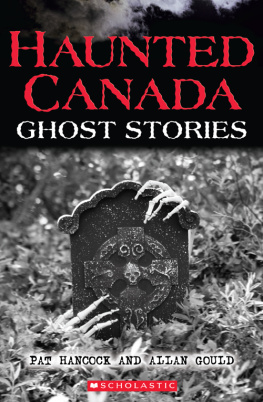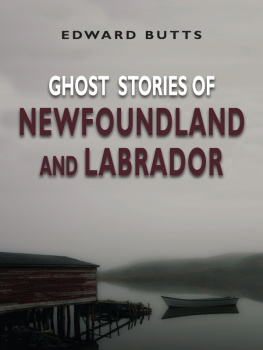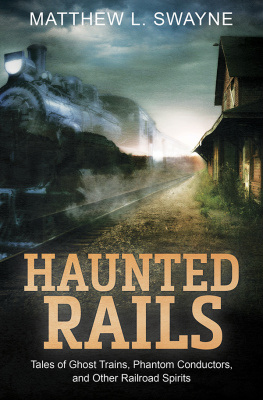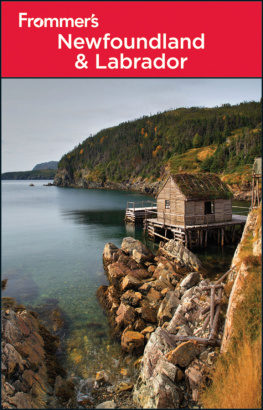HAUNTED SHORES
TRUEGHOSTSTORIES OF
NEWFOUNDLAND ANDLABRADOR
National Library of Canada Cataloguing in Publication
Jarvis, Dale Gilbert
Haunted shores: true ghost stories of Newfoundland and
Labrador / Dale Gilbert Jarvis.
ISBN 1-894463-54-4
1. Ghosts--Newfoundland and Labrador. 2. Tales--Newfoundland and Labrador. 3. Ghost stories. I. Title.
BF1472.C3J37 2004 133.109718 C2004-902011-0
Copyright 2004 by Dale Jarvis
ALL RIGHTS RESERVED. No part of the work covered by the copyright hereon may be reproduced or used in any form or by any meansgraphic, electronic or mechanicalwithout the written permission of the publisher. Any request for photocopying, recording, taping or information storage and retrieval systems of any part of this book shall be directed to the Canadian Reprography Collective, 379 Adelaide Street West, Suite M1, Toronto, Ontario M5V 1S5. This applies to classroom use as well.
Cover photo Dale Wilson
PRINTED IN CANADA
First printing May 2004
Second printing September 2004
FLANKER PRESS LTD.
P.O. BOX 2522, STATION C
ST. JOHNS, NL CANADA A1C 6K1
TOLL FREE: 1-866-739-4420 TELEPHONE: (709) 739-4477
FAX: (709) 739-4420
INFO@FLANKERPRESS.COM
WWW.FLANKERPRESS.COM

We acknowledge the financial support of the Government of Canada through the Book Publishing Industry Development Program (BPIDP) for our publishing program.
HAUNTED SHORES
TRUEGHOSTSTORIES OF
NEWFOUNDLAND ANDLABRADOR
Dale Gilbert Jarvis

INTRODUCTION
Nestled between Breakheart Hill and Bennetts Point, Trinity Bay, is the village of Champneys West. Across the Tickle from Champneys West is Fox Island, which is connected by an isthmus to the mainland. Within the isthmus is a deep freshwater pond, surrounded on either side by stony beaches.
The pond itself is famous for being bottomless, one of several reportedly bottomless ponds in Newfoundland. Of these, the best known is probably Deadmans Pond in St. Johns. Local researcher and folklorist Pamela Coristine offers an excellent synopsis of the pond story on her Gothic Lane Web site.
The legend goes that in the mid-1700s the bodies of executed criminals were displayed on a gibbet at Gibbets Hill, writes Coristine. After a time the bodies were cut down, loaded into barrels, weighed down with rocks and rolled into Deadmans Pond. Deadmans Pond was believed to be bottomless, thus ensuring the quick descent into hell of the criminals damned soul.
A direct portal to Hell in St. Johns East? Gothic stuff indeed, and as firm a fixture of St. Johns folklore as the miles of tunnels everyone knows are just waiting to be found underneath Water Street. Firm enough in fact to steel the determination of a film crew from Canadas national science fiction and fantasy cable station. They arrived in St. Johns one summer as part of a cross-Canada odyssey to explore the unexplained.
After investing in a boat rental and trolling Deadmans Pond, the adventuresome Torontonians demonstrated on national television what every Townie could have told them ahead of time, should they have felt so inclined. Deadmans pond has a bottom. It is not even that far from the surface.
While I personally have not plumbed the depths of the Fox Island pond, something tells me that it probably has a bottom as well. Most of us accept that we live on a spherical planet, and the idea of a pit that truly goes on forever is fantastic. We live in an era where satellite technology allows us to map the oceans deepest abyss, and unless NASA is holding something back, no direct entranceways to Hell have been discovered.
In spite of scientific advancements and academic treatises, legends like those of Fox Island Pond and Deadmans Pond continue to circulate, be retold, and find their way as fact into tourist literature. Why do we continue to tell these tales, and why does the idea of a bottomless lake continue to hold such a grip on our collective imagination?
Part of it must be the fact that Newfoundlanders and Labradorians love a good yarn, even those (or perhaps especially those) known to be less than one hundred percent accurate. But if you will pardon the pun, the reason may lurk deeper still.
Legends and tales of bottomless pits, lakes, and ponds are almost universal. Lake on the Mountain Provincial Park near Kingston, Ontario has a bottomless lake. So does Budapest and the town of Agias Nikolaos in Crete. There is even a Bottomless Lakes State Park near Roswell, New Mexico, which boasts more than one bottomless pond.
These lakes and ponds offer us tantalizing doorways to another realm. Sometimes this other realm is stated as in the legend of Deadmans Pond, and sometimes it is left unsaid. But peering into the reflective surface of a still body of water and wondering what lies beneath provides us with a link to the unexplained. Perhaps this is why they fascinate us. It is not so much that we think they actually are bottomless, but that part of us wishes that they might be.
So too with ghost stories, and indeed, with all things paranormal.
A number of years ago, I met a Newfoundland woman who was experimenting with infrared film. This woman had experienced a number of paranormal encounters in and around St. Johns. Using the infrared film, she was attempting to capture images of the spirits she believed she had seen in the area.
Infrared photography uses films that are sensitive to both the light we can see and some of the infrared radiation that we cannot. But does it show ghosts? The photos I saw contained strange, hard-to-define images. Whether these were ghosts, ghouls, or clouds of gas is impossible to say. What can be said for certain is that there are many people who believe that infrared and other types of film can capture things usually not visible to the naked human eye. The interpretation of those images as ghosts seemed to be more a matter of faith or belief than a matter of scientific inquiry.
This belief in ghostly photographs is not new to our haunted shores. In fact, the most famous Newfoundland ghost photo is quite historic, and is part of the archival collection of the Anglican Cathedral of St. John the Baptist in St. Johns.
The story behind the photograph is quite familiar to many, and has earned a firm place in the oral tradition of the city. According to local folklore, a workman employed on the construction of the Cathedral fell from the heights of the buildings south face. The workman died as a result of the fall, and was buried with due ceremony.
When that phase of construction was completed, the workmen involved in the project were lined up at the base of the graveyard to the south of the building. A photograph of the workers in their Sunday best was taken, with the Cathedral in the background. When the photograph was developed, a translucent figure in rough clothes was clearly visible at the end of the line of workers, and a legend was born.
Generations of non-believers, photographic experts and archivists would have you believe it is merely a coincidence. For them it is a double exposure of the sort common in an era when a long exposure time was required when snapping a photo. Julia Mathieson, the wonderful archivist at the Anglican Cathedral, assures me that there is no documentary evidence for a death of any workmen during the construction of the Cathedral. Yet the story persists, and for each skeptic, there is a person who believes in a supernatural origin. As I always say, the decision to believe, or not to believe, lies within yourself.
Next page







